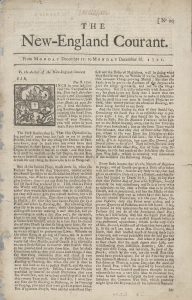by Dr. Talya Housman, Threadable Books
In the winter of 1764, smallpox descended on Boston and John Adams went to get inoculated against it. You might have heard that Edward Jenner pioneered the smallpox vaccine in 1796 – so how did Adams get inoculated in 1764?
Adams used an earlier method of inoculation called “variolation,” rather than Jenner’s “vaccination.” Inoculation is the process of introducing a small amount of viral matter into the body in order to teach the body’s immune system to fight off the virus, thus making the patient immune to future infection. Variolation used viral matter from smallpox patients, usually pus from a light case of smallpox. Jenner’s vaccination, meanwhile, used matter from the milder cowpox virus. As a milder disease carrying the same immunities, cowpox matter was much safer.
Zabdiel Boylston, the uncle of John Adams’s mother, Susanna Boylston Adams, is often credited for introducing variolation to the Americas in 1721. In fact, Onesimus, one of Cotton Mather’s slaves, told Mather of the practice and Mather convinced his friend Boylston to try inoculation.[1] Around the same time, Lady Mary Wortley Montagu had her daughter inoculated in England after learning about variolation during her husband’s diplomatic posting at the Ottoman court in Istanbul. Variolation was used in not only Africa and the Ottoman Empire but also China and India long before the Western world ever discovered this secret.
The impetus for Boylston and Mather’s efforts in 1721 was the arrival in Boston of the sixth large outbreak of smallpox.[2] Boylston began inoculating hundreds but controversy erupted over his efforts.[3] Many worried about the intentional spread of disease. Others felt that if anyone died from inoculation, Boylston was guilty of murder. Fierce debate raged in Boston between supporters and opponents of the practice of variolation. The debate did not remain on the page – Boylston was physically assaulted on the street. However, Boylston and Mather collected information on infections and were able to show that inoculation dropped the smallpox mortality rate to 1 or 2% from approximately 15%.[4] By 1749, William Douglass, the fiercest opponent of inoculation, published an essay admitting inoculation’s benefits and encouraging society to inoculate.[5]

Though variolation was well accepted by the time of Adams’s 1764 inoculation, there remained about “500 Persons, who continue to stand it out, in spight of Experience, [and] the Expostulations of the Clergy.” These individuals caused Adams to wonder if man was truly “a rational creature” since he would have seen himself as “a deliberate self Murderer” if he had refused to inoculate himself.[6] In addition, inoculation in 1764 was not an entirely uniform process. Adams wrote that in his recovery from the inoculation, “Each [doctor] has a few Particulars in Point of Diet, in which he differs from the others, and Each has Pills and Powders, different from the others to administer.”[7]
As we all wait for scientists to develop a vaccine for the coronavirus, it’s important to remember the controversy that followed the 1721 Boston inoculations as well as the gradual normalization of the variolation process that preceded Jenner’s discovery. The development, adoption, and improvement of infectious disease response are messy processes – not a single “eureka” event. It is common to have initial disagreements among experts on treatments and often the first workable treatment is later replaced with an improved option.
It’s easy to see dates like 1796 as the shining beacons in the lines of smallpox history – but to John Adams and much of Boston in 1764, they were thankful to live after 1721. Adams celebrated “Inoculation for the Small Pox” as evidence of America’s “Glory of the Invention.”[8] He praised Boylston’s 1721 “discovery” and “practice” of smallpox inoculation “which has since proved of such inestimable benefit to Mankind.”[9]
Dr. Housman’s first book project uses digital tools to explore sexual crime in seventeenth century England. She has written on numerous historical topics including slavery, suffrage, religious freedom, industrialization, charitable giving, and pandemics for various public history organizations.
[1] Stefan Riedel, “Edward Jenner and the History of Smallpox and Vaccination,” Baylor University Medical Center Proceedings, 18:1, (2005), 22.
[2] Shawn Buhr, “To Inoculate or Not to Inoculate?: The Debate and the Smallpox Epidemic of Boston in 1721,” Constructing the Past, 1:1, (2000), 63.
[3] For more on this controversy, see Christianna Elrene Thomas Hurford, “In His Arm the Scar”: Medicine, Race, and the Social Implications of the 1721 Inoculation Controversy on Boston, unpublished doctoral dissertation, (Ohio State University, 2012); Amalie M. Kass, “Boston’s Historic Smallpox Epidemic,” Massachusetts Historical Review, 14 (2012), 1-51.
[4] Buhr, “To Inoculate or Not to Inoculate,” 66.
[5] William Douglass, A Summary, Historical and Political, of the first Planting Progressive Improvements, and present State of the British Settlements in North America, (Boston: Rogers and Fowle, 1749).
[6] John Adams to Abigail Smith, 17 April 1764 in Adams Family Correspondence, Vol. 1. [link]
[7] John Adams to Abigail Smith, 14 April 1764 in Adams Family Correspondence, Vol. 1. [link]
[8] John Adams to the President of Congress No. 9, 25 February 1780 in Papers of John Adams, Vol. 8. [link]
[9] Obituary of Susanna Boylston Adams Hall, 29 April 1797 in Adams Family Correspondence, Vol. 12. [link]

